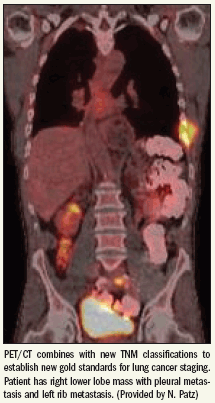Talk on new lung cancer stagingstandards stirs protocol debate
Radiologists may have to make only minor changes to their practices to adjust to the new international standards for lung cancer staging, but a lecture covering their implications was still controversial enough to send sparks flying.
Radiologists may have to make only minor changes to their practices to adjust to the new international standards for lung cancer staging, but a lecture covering their implications was still controversial enough to send sparks flying Aug. 4 at the International Association for the Study of Lung Cancer meeting in San Francisco.
The point of contention during a question and answer session arose after plenary lecturer Dr. Ned Patz, a thoracic radiologist from Duke University in North Carolina, recommended noncontrast thoracic CT for staging. He had advised some 2000 physicians in the audience that whether to use contrast enhancement is a hotly debated question. That point proved true when Dr. John C. Ruckdeschel, CEO of the Nevada Cancer Institute, took to the microphone to challenge the recommendation.

“I’m flabbergasted by your recommendation that we do noncontrast CT as the initial staging study,” Ruckdeschel said. “In 30 years of sitting with surgeons every week, time and again we see these low-bid community CTs that are uncontrasted and worse than a chest x-ray. I am petrified that your slide will make it out into the community.”
In his defense, Patz referred to a study performed by his group at Duke to compare blinded readings of staging CT for lung cancers performed with and without contrast.
“Granted that it was in a tertiary care institution with thoracic radiologists doing it on the best equipment, but after 120 patients, our statistician told us to stop because the results were so highly statistically significant,” he said. “I understand your concern, but we could not find a difference [between the contrast and noncontrast studies].”
In the lecture, Patz noted that radiologists are actually moving away from both contrast and noncontrast CT for staging. FDG PET/CT has become the modality of choice for staging. Its application obviates dedicated thoracic CT or a nuclear bone scan, he said.
Initial diagnosis is still usually based on chest x-rays. They provide an enormous amount of information for staging the disease, he said.
Policies vary from hospital to hospital on the need for brain imaging. Data suggest that about 10% of asymptomatic patients will have brain metastases, but the clinical value of characterizing their presence is uncertain, Patz said.
Patz praised International Association for the Study of Lung Cancer (IASLC) officials for undertaking the exhaustive evidence-based effort to modify its TNM staging classification system for lung cancer. Forty-seven databases involving more than 100,000 cases from collaborators around the world were used for staging and outcomes analysis.
“What is amazing about this whole effort is that it has been evidencedbased,” he said.
For staging of tumors, radiologists will be asked to adjust to new size criteria for T1, T2, and T3 lesions, he said.
T1 tumors were divided into T1a, tumors less than 2 cm in diameter, and T1b, tumors larger than 2 cm but no larger than 3 cm.
T2 tumors were subdivided as well. T2a tumors are larger than 3 cm in diameter but smaller than 5 cm. T2b tumors are larger than 5 cm and smaller than 7 cm. Tumors that are larger than 5 cm have been moved into stage T2a, however, when they are associated with node-negative disease.
A new classification of T3 tumors covers lesions that are larger than 7 cm in diameter. When these large tumors are node-negative, they are now staged at T2b. When they are associated with N1 disease, they become stage 3a.
T4 tumors with additional tumor nodules in the same lobe as the primary tumor were reclassified. They are now referred to as T3 tumors. When additional tumor nodules are negative, the disease is staged as T2b.
T4 tumors with malignant pleural effusions present were also reclassified. This condition is now referred to as M1 disease.
Radiologists should physically measure tumor diameter because of the new size criteria for T1, T2, and T3 lesions, Patz said. Seven of 10 patients will harbor at least one nodule 5 mm or smaller. Most of these lesions will be benign, but the radiologist should carefully identify any nodes in either the ipsilateral or contralateral lobe.
The N descriptors have not changed, but they have been validated in the current system: zero is no disease and N1 is ipsilateral hilar disease, Patz said.
For M descriptors, cases that were previously considered M1 because of the presence of additional pulmonary nodules in the ipsilateral lobe are now referred to as T4.
Cases with additional nodules in the contralateral lung are still classified as M1 but have been put into the new subcategory of M1a. Patients with distant metastases are now reclassified as having M1b disease.
These standards apply to all medical institutions globally and will remain active until the 8th edition of the IASLC staging system is published in 2016. That version will address the need to understand the biology of disease, Patz said. IASLC officials are particularly interested in quantifiable physiological measures, such as standard uptake values acquired with FDG PET.
The IASLC has prepared a pocket-sized handbook in numerous languages and a detailed manual describing the new staging system. For more information, see www.iaslc.org.
GE HealthCare Debuts AI-Powered Cardiac CT Device at ACC Conference
April 1st 2025Featuring enhanced low-dose image quality with motion-free images, the Revolution Vibe CT system reportedly facilitates improved diagnostic clarity for patients with conditions ranging from in-stent restenosis to atrial fibrillation.
The Reading Room Podcast: Current Perspectives on the Updated Appropriate Use Criteria for Brain PET
March 18th 2025In a new podcast, Satoshi Minoshima, M.D., Ph.D., and James Williams, Ph.D., share their insights on the recently updated appropriate use criteria for amyloid PET and tau PET in patients with mild cognitive impairment.